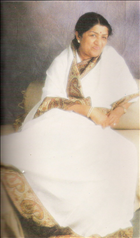


As the Hindi film music- the most popular Indian music genre fast goes on shedding its independent, indigenous entity and rushes headlong onto an irreversible path of becoming a so-called global entity; remembering and re-analyzing the Indian Melody Queen Lata Mangeshkar’s musical legacy assumes greater significance. Tomorrow- who knows we might not even get to hear Hindi film-songs in the manner that we have grown up listening to! The ‘One World, One Sound’ practice- an inevitable product of changing times and trends, might turn everything into a musical mishmash that might be difficult to identify as Indian music!
Tales of triumph
It was 1942, when Lata entered into the realms of film-music - a fourteen year-old Maharashtrian girl who had just lost her father and who had three younger sibs and a widowed mother to support! How that tiny girl triumphed over adversity and competition through sheer talent and steely determination; how she broke away from established norms to develop a unique rendition-style and how she went on to rule the music-industry and hearts of millions, in the process becoming an integral part of an entire nation’s socio-cultural fabric- these stories have now become part of the folklore. But Lata’s contribution to Indian music scene is far more than these tales of triumphs and it is not only about her melodious voice and an enviable array of unforgettable musical gems.
Woman in a man’s world
A single woman dominating a totally male-oriented film- industry full of colossal egos and talents- that to me is her most underrated but perhaps most impressive achievement and that she did it not on the basis of money-or muscle-power but just through her musical ability. Detractors have called her manipulating and have questioned her monopoly but few know the headstrong way in which she fought her industry-battles in her prime era of late 1950s-60s, without a care for her future career. No other artist would have then survived locking horns with industry bigwigs like S.D.Burman, O.P.Nayyar, C.Ramchandra, Shankar, Mohd. Rafi and Raj Kapoor- particularly when thanks to those spats, plum songs kept going out to competitors and imitators for years. But Lata not only survived those skirmishes but in fact emerged stronger-only because of her exceptional ability to deliver hits with practically any composer and any film-maker.
Nightingale Of India
Musically she brought a sea-change in the way film-songs were rendered. From the heavy, mushy, melodramatic rendition patterns of 1930-1940s, she brought a rare finesse, softness and subtlety of expression into film-songs. Even in a medium as commercially driven as film-music, Lata’s prime year-output stood out for dignity, decorum and a divine sense of spirituality. Indian classical and folk- tunes and typically Indian emotional values consistently reflected through her songs. Rightfully she earned the sobriquet of ‘Nightingale of India’ and even won the highest national honour- ‘Bharat Ratna’. One of her major achievements was to win respect from the high-brow critics and classical musicians who had till then always rejected claims of film-music in terms of enduring artistic value. Bade Ghulam Ali Khan- the greatest exponent of Indian classical music calling her ‘Ustadon Ki Ustad’ (Master of masters) was indeed high praise!
Decline of the legend
Like any iconic career stretching too long, Lata too had to endure a definite fall in her artistic standards. The advancing age took away the creative edge and aesthetic charm of her voice but even with her sub-par voice, surprisingly she still managed to dish out super-successful albums with regularity. So when talking of other singers, we think of number of their hit songs but for Lata, we have to think of the number of hit soundtracks full of her songs! Often it has been opined that she should have quit long ago but perhaps by choosing to remain in the limelight of showbiz, she not only managed to win contemporary commercial laurels but also enticed new generations of listeners towards the treasure-trove of her golden-era songs.
Never Before, Never Again
With the years rolling on, a growing realization dawns that given the changing scenario of Hindi film music or for that matter of the entire world in general, we might not ever have another artiste measuring up to Lata’s standards again. Why? Not because there won’t be anyone better but simply because today, even, that better somebody will not ever have the conducive sociocultural and musical environment to provide full artistic expression of her talent.
Another factor that has ensured Lata’s sole place at the top in history is the growing emotional detachment of today’s listeners towards current artists- thanks to a frenetic pace of life, which has left no time for fans to analyze, appreciate and get deeply attached to their idol’s music.
Lata came from an era when the life’s pace was much relaxed, allowing the audience to sit back, enjoy and connect to the real musical facets of a song and to her full credit, she used that creative environment to the fullest. She inspired the lyricists to come up with best of the words and spurred composers to conjure the most imaginative melodies and then she added her own exquisite Lata-touch to make them immortal classics. Hers is a success not only of an individual but of an entire musical genre which thrived on her virtuosity and gave us some of the most cherished musical moments!
**********************************************************************
Lata –Top Songs
Here is a quick look at some of the most significant songs in her career. There are at least a thousand songs left out of the queue!